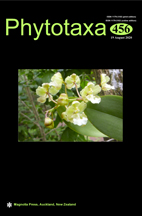Abstract
Two new species of Stylosanthes Sw. (Leguminosae), S. minima and S. mitzii, endemic to central-southern Bahia State, in northeastern Brazil, are described and illustrated. The species differ from each other principally by the length of the fruit rostrum, the presence or absence of indumentum, the shapes or sizes of their bracts and bract leaflets, and numbers of spikes per inflorescence. Stylosanthes minima differs from S. macrocephala by having the upper segments of the fruit pilose to extremely pubescent (vs. glabrescent), rostrum with 0.5–1 mm long (vs. 1.5–2.5 mm long), and by the number of spikes (2–7 vs. 1–3). Stylosanthes mitzii differs from S. capitata by having bracts oval (vs. elliptic), bract leaflets lanceolate (vs. elliptic), and rostrum shorter (0.5–1.5 mm long vs. 2–2.5 mm long). An identification key is provided for all the known species with an axis rudiment from Bahia State, as well as data concerning the micromorphology of the fruits, images, and maps.

